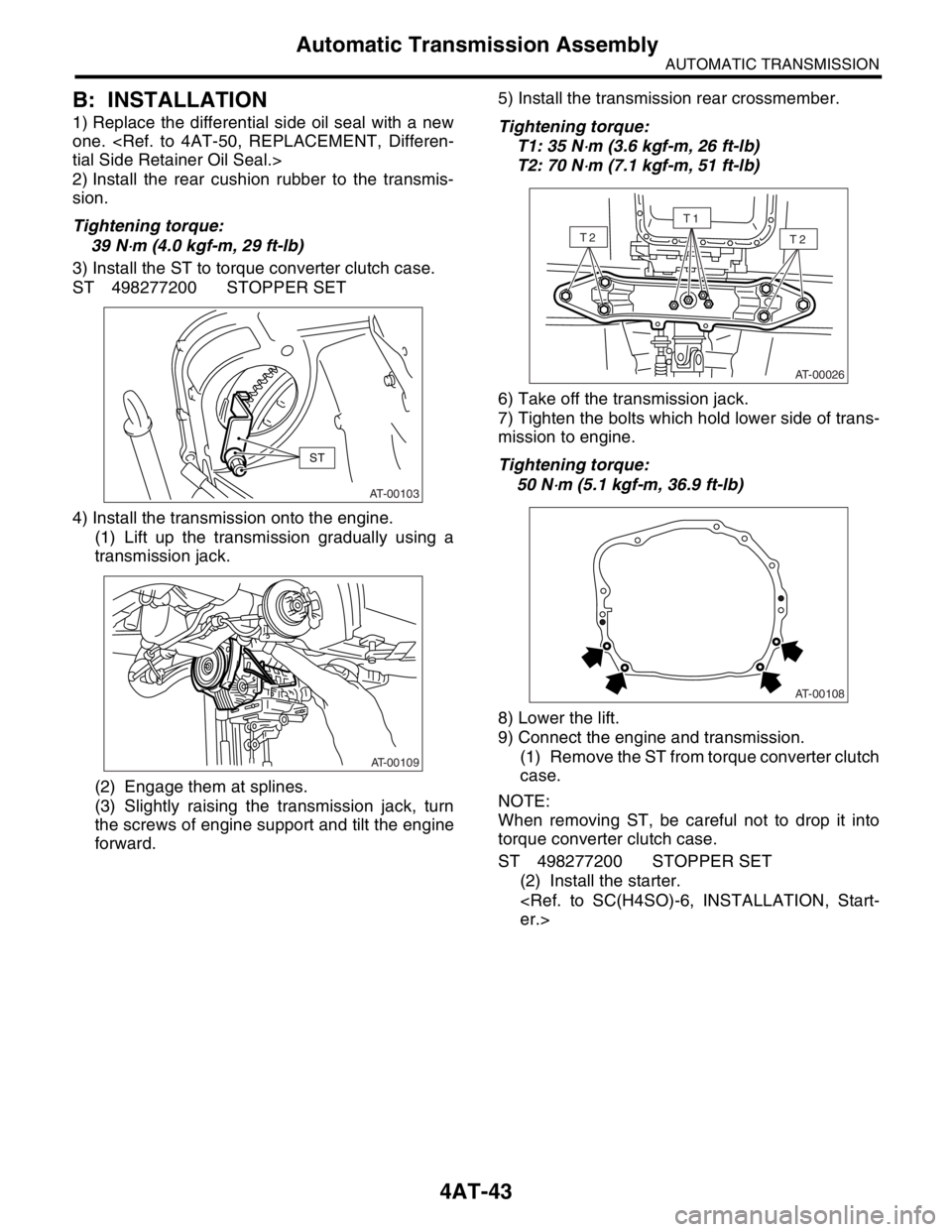2004 SUBARU FORESTER stop start
[x] Cancel search: stop startPage 2344 of 2870

4AT-32
AUTOMATIC TRANSMISSION
Road Test
4. Road Test
A: INSPECTION
1. GENERAL PRECAUTION
Road tests should be conducted to properly diag-
nose the condition of the automatic transmission.
NOTE:
When performing the test, do not exceed posted
speed limit.
2. D RANGE SHIFT FUNCTION
Check shifting between 1st ←→ 2nd ←→ 3rd ←→
4th while driving on normal city streets.
3. D RANGE SHIFT SHOCK
Check the shock level when shifting up during nor-
mal driving.
4. KICK-DOWN FUNCTION
Check kick-down for each gear. Also check the
kick-down shock level.
5. ENGINE BRAKE OPERATION
Check the 3rd gear engine brake when shifting
down from D ←→ 3rd range while driving in 4th
gear of D range [50 — 60 km/h (31 — 37 MPH)].
Check the 2nd gear engine brake when shifting
between 3rd ←→ 2nd range while driving in the 3rd
range of 3rd gear [40 — 50 km/h (25 — 31 MPH)].
Check the 1st gear engine brake when shifting
between 2nd ←→ 1st range while driving in the 2nd
range of 2nd gear [20 — 30 km/h (12 — 19 MPH)].
6. LOCK-UP FUNCTION
Check that rpm does not change sharply when
the axle pedal is lightly depressed when driving on
flat roads at 60 km/h (37 MPH).
Check slip lock-up with following procedure.
Subaru Select Monitor is needed for checking (EC,
EK model).
Before start checking, check that the DTC is not ex-
isted using Subaru Select Monitor. When the DTC
is existed, perform the collective action with DTC
and check that the DTC is not existed again, and
then start the checking.
1) The check performed on flat and straight road or
free roller.
NOTE:
Slip lock-up does not operate when the vehicle is
lifted up, because of not occurring surface resis-
tance.
Also checking on the free roller, check with de-
pressing foot brake lightly to make the checking
easier, because the surface resistance will be defi-
cient2) Connect the Subaru Select Monitor.
3) Check ATF temperature using Subaru Select
Monitor.
NOTE:
ATF temperature is between 50 — 100°C (122
— 212°F).
When the temperature is low, warm-up the ATF
by running the vehicle or etc.
4) Start the engine, and make the lock-up duty be
able to read on data display of Subaru Select Mon-
itor.
5) 35 — 40 Drive the vehicle at a constant speed of
35 — 40 km/h (22 — 25 MPH).
6) Read the lock-up duty while vehicle is running.
Standard value:
25 — 45%
NOTE:
On the free roller, the value sometimes lowers.
Slip lock-up control is not operating when the
lock-up duty is less than 5%, or when the lock-up
duty goes down immediately after starts rise. On
these cases, improper ATF or deterioration of ATF
may be the cause. Check the amount of ATF or re-
place them, and then recheck it.
7. P RANGE OPERATION
Stop the vehicle on an uphill grade of 5% or more
and shift to “P” range. Check that the vehicle does
not move when the parking brake is released.
8. NOISE AND VIBRATION
Check for unusual sounds and vibration while driv-
ing and during shifting.
9. CLIMBING CONTROL FUNCTION
Check that the gear remains in 3rd when going
up a grade.
Check that the gear remains in 3rd when apply-
ing the brakes while going down a grade.
10.TRANSFER CLUTCH
Check tight corner braking when the vehicle started
with steering fully turned.
11.OIL LEAKS
After the driving test, inspect for oil leaks.
Page 2347 of 2870

4AT-35
AUTOMATIC TRANSMISSION
Time Lag Test
6. Time Lag Test
A: INSPECTION
NOTE:
If the select lever is shifted while the engine is
idling, there will be a certain time elapse or lag be-
fore the shock can be felt. This is used for checking
the condition of the low clutch, reverse clutch, low &
reverse brake and one-way clutch.
Perform the test at normal operation fluid tem-
perature 70 — 80°C (158 — 176°F).
Be sure to allow a one minute interval between
tests.
Perform measurement for three times and take
the average value.
1) Fully apply the parking brake.
2) Start the engine.
Check the idling speed (A/C OFF).
3) Shift the select lever from “N” to “D” range.
Using a stop watch, measure the time it takes from
shifting the lever until the shock is felt.
Time lag: Less than 1.2 seconds
If “N” → “D” time lag is longer than specified:
Line pressure too low
Low clutch worn
One-way clutch not operating properly
D-ring worn
4) In the same manner, measure the time lag for
“N” → “R”.
Time lag: Less than 1.5 seconds
If “N” → “R” time lag is longer than specified:
Line pressure too low
Reverse clutch worn
Low & reverse brake worn
D-ring worn
Page 2355 of 2870

4AT-43
AUTOMATIC TRANSMISSION
Automatic Transmission Assembly
B: INSTALLATION
1) Replace the differential side oil seal with a new
one.
2) Install the rear cushion rubber to the transmis-
sion.
Tightening torque:
39 N
⋅m (4.0 kgf-m, 29 ft-lb)
3) Install the ST to torque converter clutch case.
ST 498277200 STOPPER SET
4) Install the transmission onto the engine.
(1) Lift up the transmission gradually using a
transmission jack.
(2) Engage them at splines.
(3) Slightly raising the transmission jack, turn
the screws of engine support and tilt the engine
forward.5) Install the transmission rear crossmember.
Tightening torque:
T1: 35 N
⋅m (3.6 kgf-m, 26 ft-lb)
T2: 70 N
⋅m (7.1 kgf-m, 51 ft-lb)
6) Take off the transmission jack.
7) Tighten the bolts which hold lower side of trans-
mission to engine.
Tightening torque:
50 N
⋅m (5.1 kgf-m, 36.9 ft-lb)
8) Lower the lift.
9) Connect the engine and transmission.
(1) Remove the ST from torque converter clutch
case.
NOTE:
When removing ST, be careful not to drop it into
torque converter clutch case.
ST 498277200 STOPPER SET
(2) Install the starter.
ST
AT-00109
AT-00026
T2T2
T1
AT-00108
Page 2479 of 2870

4AT(H4SO)-20
AUTOMATIC TRANSMISSION (DIAGNOSTIC)
Read Diagnostic Trouble Code (DTC)
7. Read Diagnostic Trouble Code (DTC)
A: OPERATION
1. WITHOUT SUBARU SELECT MONITOR
Step Check Yes No
1 PERFORM READ DTC.
1) Warm-up the engine.
2) Turn the ignition switch to OFF.
3) Turn the ignition switch to ON.
4) Start the engine.
5) Drive the vehicle at speeds greater than 20
km/h (12 MPH).
6) Stop the vehicle.
7) The brake pedal depressed and move
select lever to 1 range.
8) Turn the ignition switch to OFF.
9) Turn the ignition switch to ON.
10)Move the select lever “2” range.
11)Move the select lever “1” range.
12)Move the select lever “2” range.
13)Move the select lever “3” range.
14)Move the select lever “D” range.Does the POWER indicator
light blink at 4 Hz intervals?
NOTE: Blinks every 0.125 (1/8)
seconds (until the ignition
switch is turned OFF).Go to step 2.Repair the power
supply and ground
circuit.
CHECK POWER
SUPPLY AND
GROUND LINE,
INSPECTION,
Power Indicator
Light Display.>
2 CHECK POWER INDICATOR LIGHT.Does the POWER indicator
light blink at 2 Hz intervals?
NOTE: Blinks every 0.25 (1/4)
seconds (until ignition switch is
turned to OFF).The AT system is
normal.Go to step 3.
3 CHECK POWER INDICATOR LIGHT.Is the DTC outputted by the
blink of POWER indicator
light?Inspect the prob-
lem correspond-
ing with DTC.
N
OTE:
Record all DTCs.Go to step 4.
4 CHECK POWER INDICATOR LIGHT.Does the POWER indicator
light remain illuminated?Repair the
POWER indicator
light circuit
INSPECTION,
Power Indicator
Light Display.>, or
Inspect inhibitor
switch, wiring,
TCM, etc.Calling up the DTC
again.
Page 2528 of 2870

4AT(H4SO)-69
AUTOMATIC TRANSMISSION (DIAGNOSTIC)
Diagnostic Procedure with Diagnostic Trouble Code (DTC)
5 CHECK OUTPUT SIGNAL EMITTED FROM
TCM.
1) Connect all connectors.
2) Start the engine and warm-up the transmis-
sion until ATF temperature is above 80°C
(176°F).
N
OTE:
If ambient temperature is below 0°C (32°F),
drive the vehicle until ATF reaches its operating
temperature.
3) Turn the ignition switch to ON (engine
OFF).
4) Move the select lever to “N” range.
5) Throttle fully closed.
6) Measure the voltage between TCM con-
nector and chassis ground.
Connector & terminal
(B54) No. 9 (+) — Chassis ground (
−):Is the voltage 1.5 — 5.0 V? Go to step 6.Go to step 9.
6 CHECK OUTPUT SIGNAL EMITTED FROM
TCM.
1) Throttle fully open and hold it.
2) Measure the voltage between TCM con-
nector and chassis ground.
Connector & terminal
(B54) No. 9 (+) — Chassis ground (
−):Is the voltage less than 1 V? Even if the
POWER indicator
light was blinking,
the circuit has
returned to a nor-
mal condition at
this time. A tempo-
rary poor contact
of the connector or
harness may be
the cause. Repair
the harness or
connector in trans-
mission.Go to step 9.
7 CHECK OUTPUT SIGNAL EMITTED FROM
TCM USING SUBARU SELECT MONITOR.
1) Connect the connectors to TCM and trans-
mission.
2) Connect the Subaru Select Monitor to data
link connector.
3) Start the engine and turn Subaru Select
Monitor switch to ON.
4) Warm-up the transmission until ATF tem-
perature is above 80°C (176°F).
N
OTE:
If ambient temperature is below 0°C (32°F),
drive the vehicle until ATF reaches its operating
temperature.
5) Stop the engine and turn ignition switch to
ON (engine OFF).
6) Move the select lever to “N” range.
7) Throttle is fully closed.
Line pressure duty solenoid is indicated in
“%”.
8) Read the data of line pressure duty sole-
noid using Subaru Select Monitor.Is the value 100%? Go to step 8.Go to step 9. Step Check Yes No
Page 2531 of 2870

4AT(H4SO)-72
AUTOMATIC TRANSMISSION (DIAGNOSTIC)
Diagnostic Procedure with Diagnostic Trouble Code (DTC)
5 CHECK OUTPUT SIGNAL EMITTED FROM
TCM.
1) Connect all connectors.
2) Start the engine and warm-up the transmis-
sion until ATF temperature is above 80°C
(176°F).
N
OTE:
If ambient temperature is below 0°C (32°F),
drive the vehicle until ATF reaches its operating
temperature.
3) Turn the ignition switch to ON (engine
OFF).
4) Move the select lever to “N” range.
5) Throttle fully closed.
6) Measure the voltage between TCM con-
nector and chassis ground.
Connector & terminal
(B54) No. 18 (+) — Chassis ground (
−):Is the voltage 1.5 — 5.0 V? Go to step 6.Go to step 9.
6 CHECK OUTPUT SIGNAL EMITTED FROM
TCM.
1) Throttle fully open and hold it.
2) Measure the voltage between TCM con-
nector and chassis ground.
Connector & terminal
(B54) No. 18 (+) — Chassis ground (
−):Is the voltage less than 1 V? Even if the
POWER indicator
light was blinking,
the circuit has
returned to a nor-
mal condition at
this time. A tempo-
rary poor contact
of the connector or
harness may be
the cause. Repair
the harness or
connector in TCM
and transmission.Go to step 9.
7 CHECK OUTPUT SIGNAL EMITTED FROM
TCM USING SUBARU SELECT MONITOR.
1) Connect all connectors.
2) Connect the Subaru Select Monitor to data
link connector.
3) Start the engine and turn Subaru Select
Monitor switch to ON.
4) Warm-up the transmission until ATF tem-
perature is above 80°C (176°F).
NOTE:
If ambient temperature is below 0°C (32°F),
drive the vehicle until ATF reaches its operating
temperature.
5) Stop the engine and turn ignition switch to
ON (engine OFF).
6) Move the select lever to “N” range.
7) Throttle is fully closed.
2-4 brake duty solenoid is indicated in “%”.
8) Read the data of 2-4 brake duty solenoid
using Subaru Select Monitor.Is the value 100%? Go to step 8.Go to step 9. Step Check Yes No
Page 2646 of 2870

4AT(H4DOTC)-70
AUTOMATIC TRANSMISSION (DIAGNOSTIC)
Diagnostic Procedure with Diagnostic Trouble Code (DTC)
4 PREPARE SUBARU SELECT MONITOR.Do you have a Subaru Select
Monitor?Go to step 7.Go to step 5.
5 CHECK OUTPUT SIGNAL FROM TCM.
1) Connect all connectors.
2) Start the engine and warm-up the engine
until ATF temperature is above 80°C (176°F).
N
OTE:
If ambient temperature is below 0°C (32°F),
drive the vehicle until ATF reaches its operating
temperature.
3) Turn the ignition switch to ON (engine
OFF).
4) Shift the select lever to “R” range.
5) Close the throttle fully.
6) Measure the voltage between TCM con-
nector and chassis ground.
Connector & terminal
(B56) No. 20 (+) — Chassis ground (
−):Is the voltage 5.0 — 7.0 V? Go to step 6.Go to step 9.
6 CHECK OUTPUT SIGNAL FROM TCM.
1) Open the throttle fully.
2) Measure the voltage between TCM con-
nector and chassis ground.
Connector & terminal
(B56) No. 20 (+) — Chassis ground (
−):Is the voltage 3.0 — 5.0 V? Even if the POWER
indicator light was
blinking, the circuit
has returned to a
normal condition at
this time. A tempo-
rary poor contact of
the connector or
harness may be the
cause. Repair the
harness or connec-
tor in transmission.Go to step 9.
7 CHECK OUTPUT SIGNAL FROM TCM US-
ING SUBARU SELECT MONITOR.
1) Connect the connectors to TCM and trans-
mission.
2) Connect the Subaru Select Monitor to data
link connector.
3) Start the engine and turn Subaru Select
Monitor switch to ON.
4) Warm-up the transmission until ATF tem-
perature is above 80°C (176°F).
NOTE:
If ambient temperature is below 0°C (32°F),
drive the vehicle until ATF reaches its operating
temperature.
5) Stop the engine and turn ignition switch to
ON (engine OFF).
6) Shift the select lever to “R” range.
7) Read the data of line pressure linear sole-
noid using Subaru Select Monitor.
Line pressure linear solenoid is indicated in
“%”.
8) Throttle is fully closed.Is the value 45 — 50%? Go to step 8.Go to step 9. Step Check Yes No
Page 2650 of 2870

4AT(H4DOTC)-74
AUTOMATIC TRANSMISSION (DIAGNOSTIC)
Diagnostic Procedure with Diagnostic Trouble Code (DTC)
7 CHECK OUTPUT SIGNAL FROM TCM US-
ING SUBARU SELECT MONITOR.
1) Connect the connectors to TCM and trans-
mission.
2) Connect the Subaru Select Monitor to data
link connector.
3) Start the engine and turn Subaru Select
Monitor switch to ON.
4) Warm-up the transmission until ATF tem-
perature is above 80°C (176°F).
N
OTE:
If ambient temperature is below 0°C (32°F),
drive the vehicle until ATF reaches its operating
temperature.
5) Stop the engine and turn ignition switch to
ON (engine OFF).
6) Shift the select lever to “P” or “N” range.
7) Read the data of low clutch duty solenoid
using Subaru Select Monitor.
Low clutch duty solenoid is indicated in “%”.Is the value 100%? Go to step 8.Go to step 9.
8 CHECK OUTPUT SIGNAL FROM TCM US-
ING SUBARU SELECT MONITOR.
1) Turn the ignition switch to ON (engine
OFF).
2) Shift the select lever to “D” range.
3) Read the data of low clutch duty solenoid.Is the value 0%? Even if the POWER
indicator light was
blinking, the circuit
has returned to a
normal condition at
this time. A tempo-
rary poor contact of
the connector or
harness may be the
cause. Repair the
harness or connec-
tor in transmission.Go to step 9.
9 CHECK POOR CONTACT.Is there poor contact in low
clutch duty solenoid circuit?Repair the poor
contactReplace the TCM.
trol Module
(TCM).>
10 CHECK LOW CLUTCH DUTY SOLENOID (IN
TRANSMISSION).
1) Remove the transmission connector from
bracket.
2) Drain the ATF.
CAUTION:
Do not drain the ATF until it cools down.
3) Remove the oil pan, and disconnect con-
nector from low clutch duty solenoid.
4) Measure the resistance between low clutch
duty solenoid connector and transmission
ground.
Connector & terminal
(AT12) No. 2 — Transmission ground:Is the resistance 2.0 — 4.5 Ω? Go to step 11.Replace the con-
trol valve body.
Body.>
11 CHECK HARNESS CONNECTOR BETWEEN
TRANSMISSION AND LOW CLUTCH DUTY
SOLENOID.
Measure the resistance of harness between
low clutch duty solenoid and transmission con-
nector.
Connector & terminal
(T4) No. 4 — (AT12) No. 2:Is the resistance less than 1
Ω?Go to step 12.Repair the open
circuit in harness
between low clutch
duty solenoid and
transmission con-
nector. Step Check Yes No